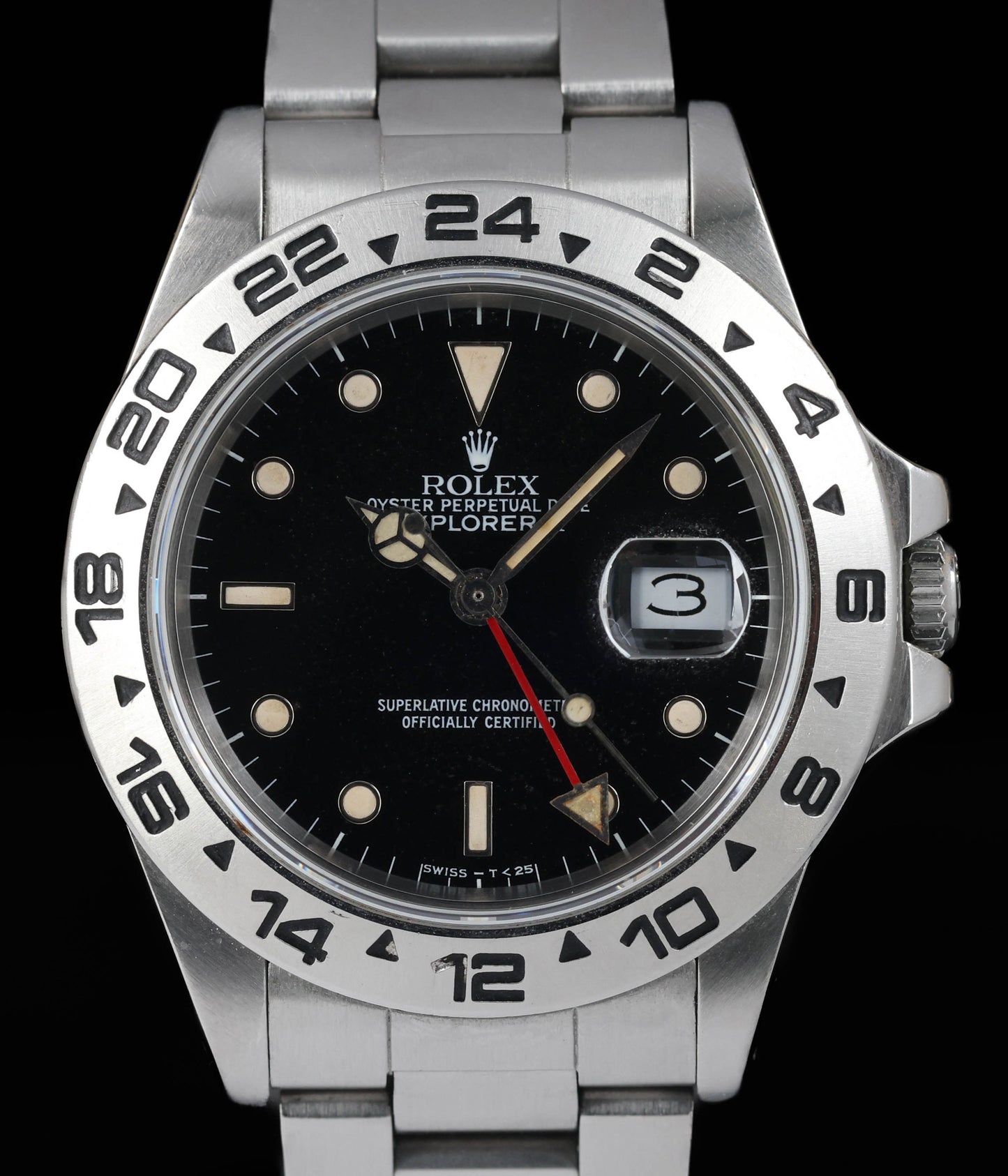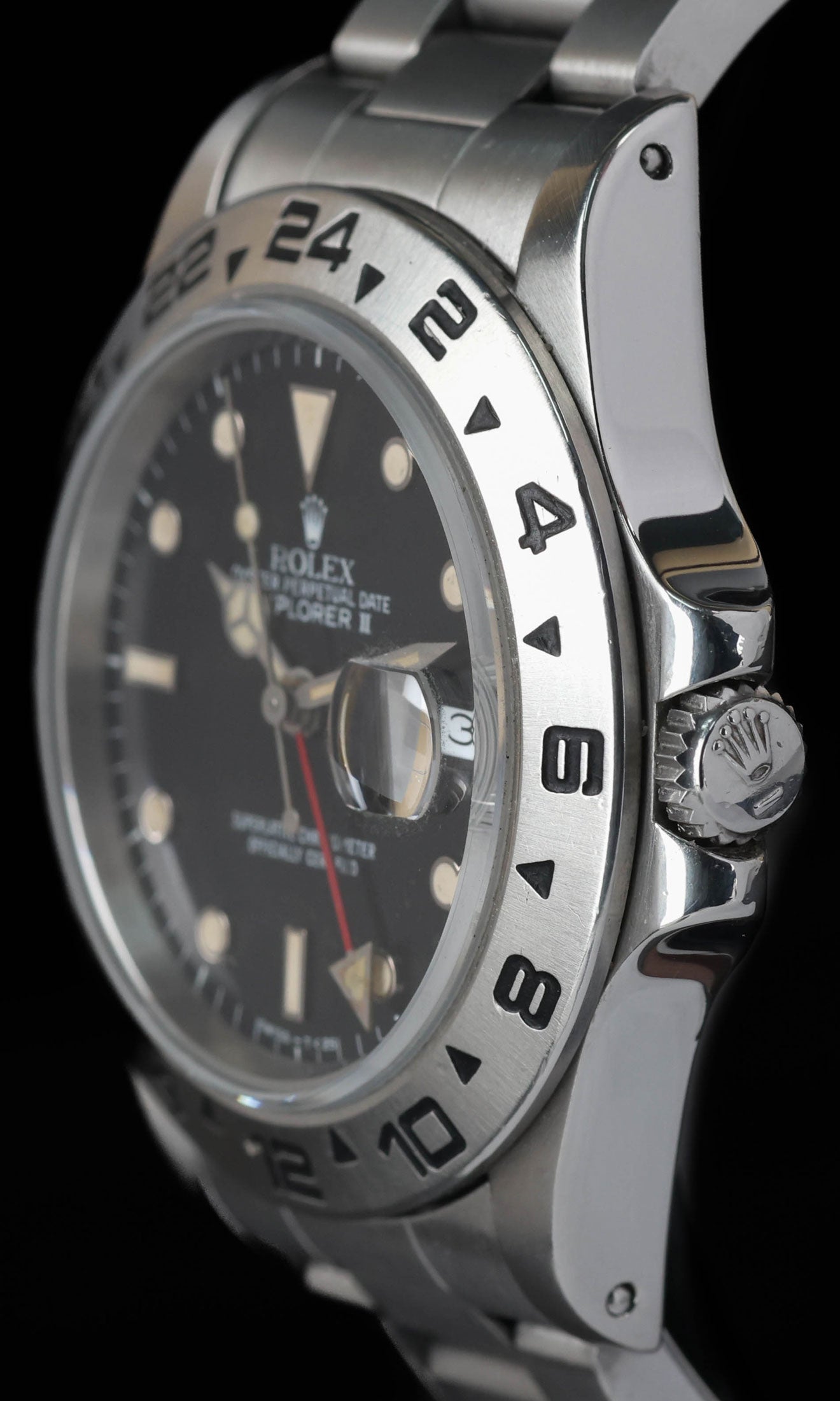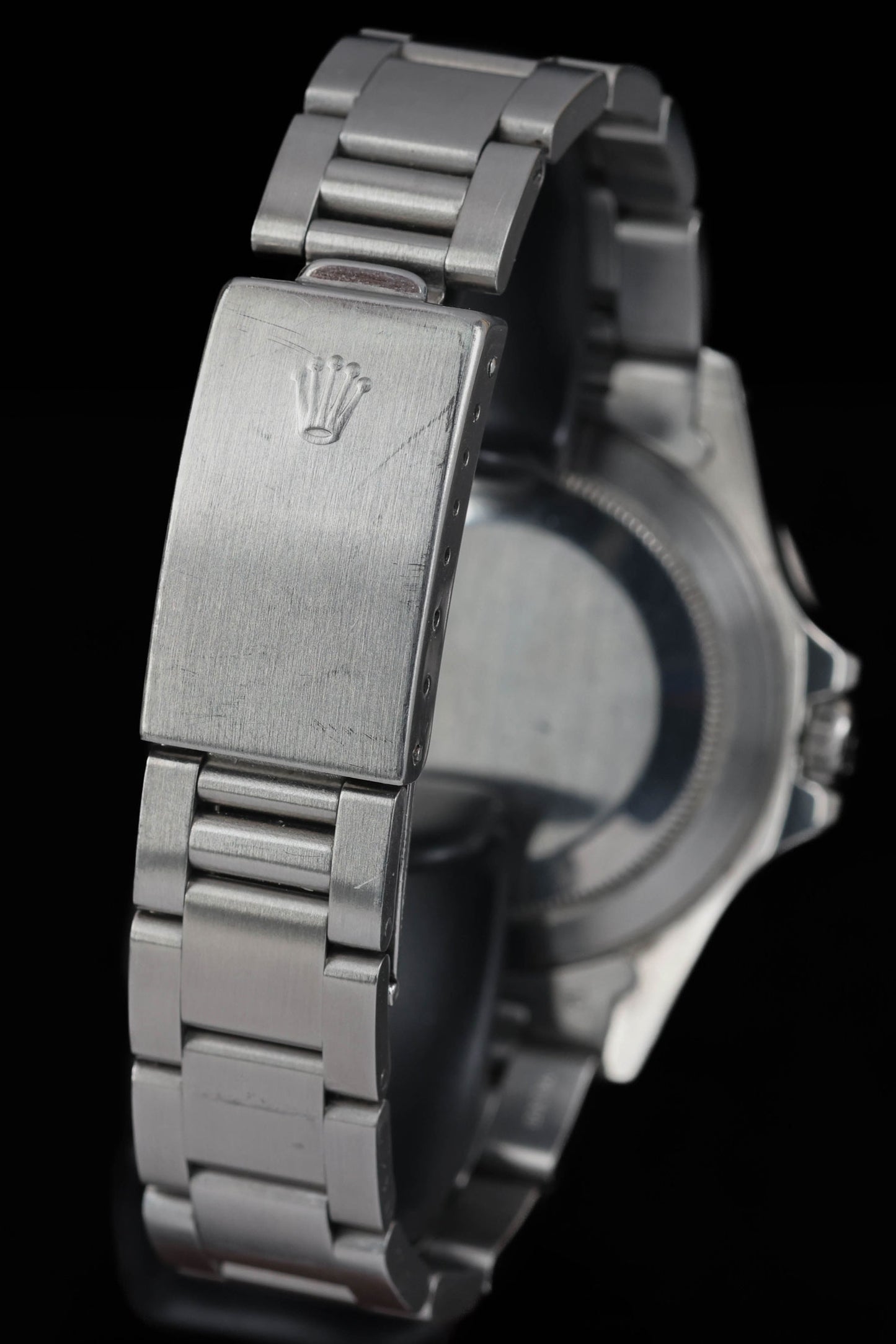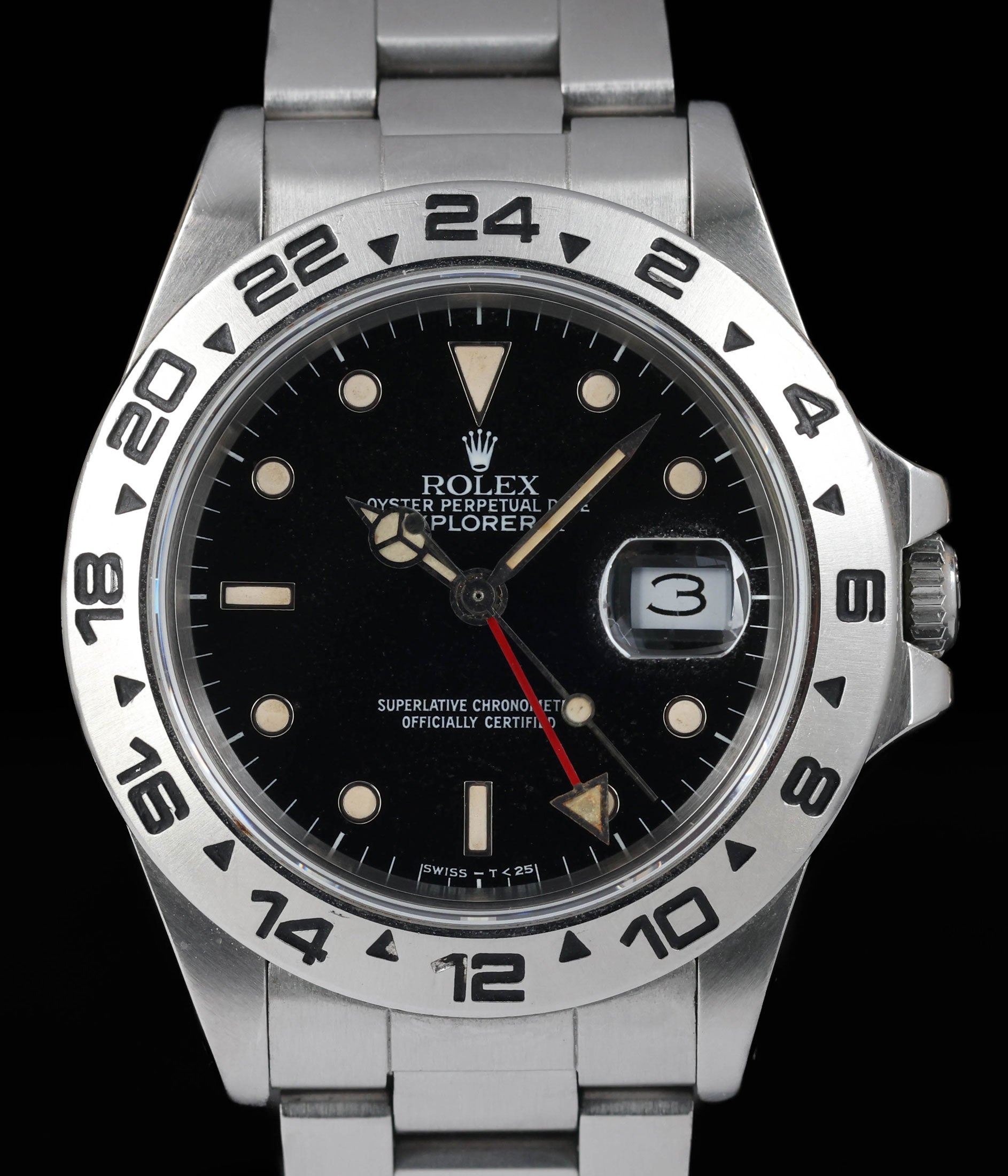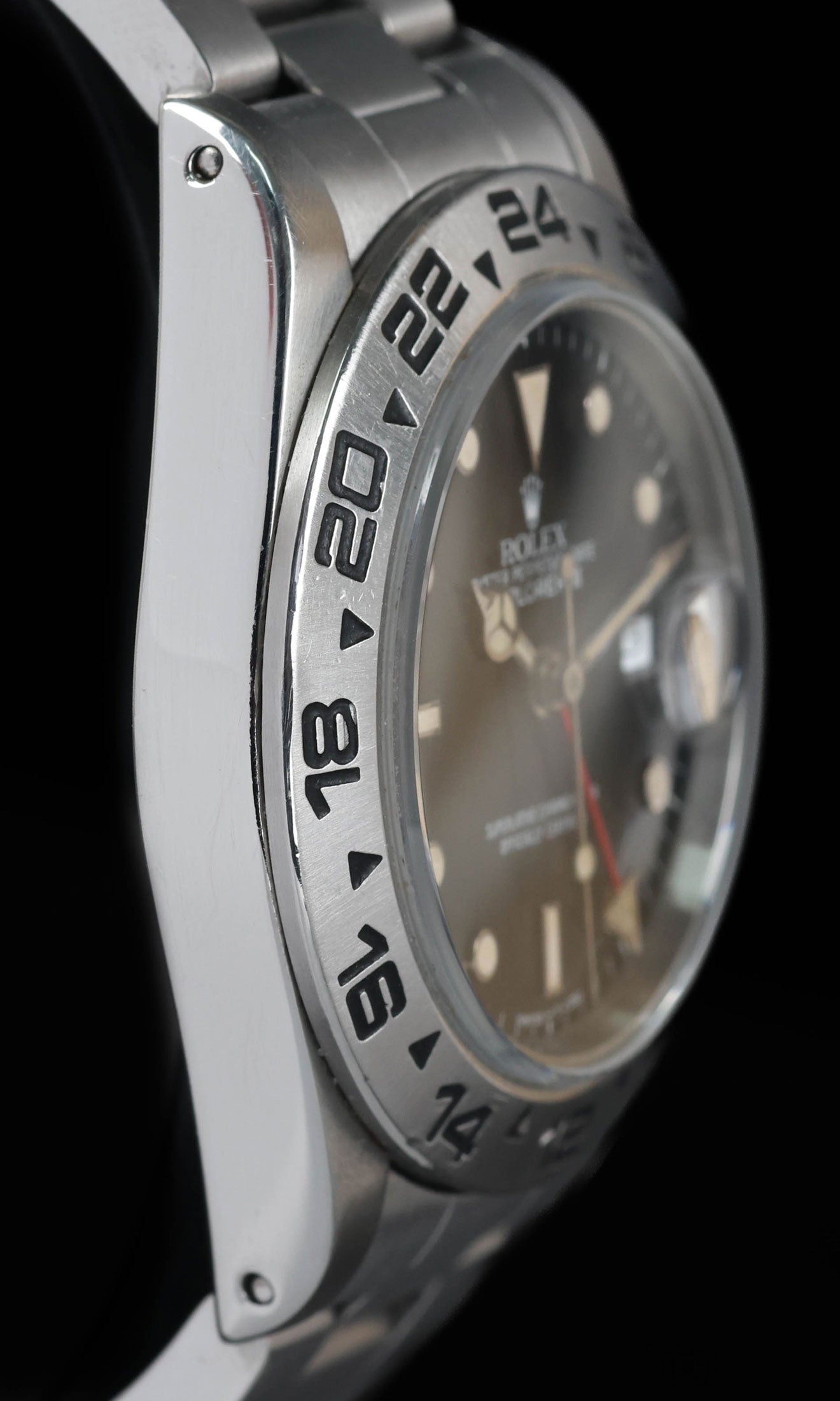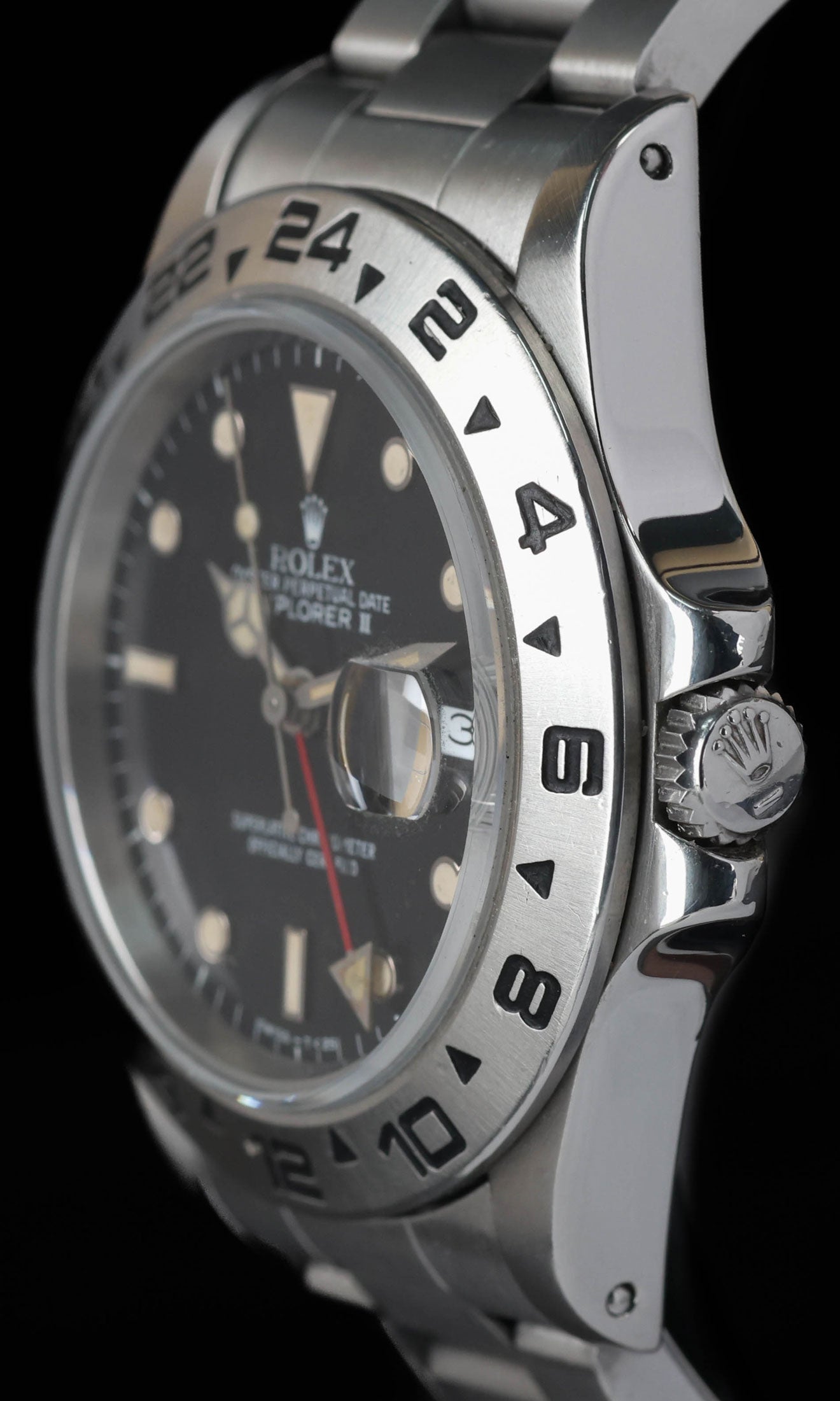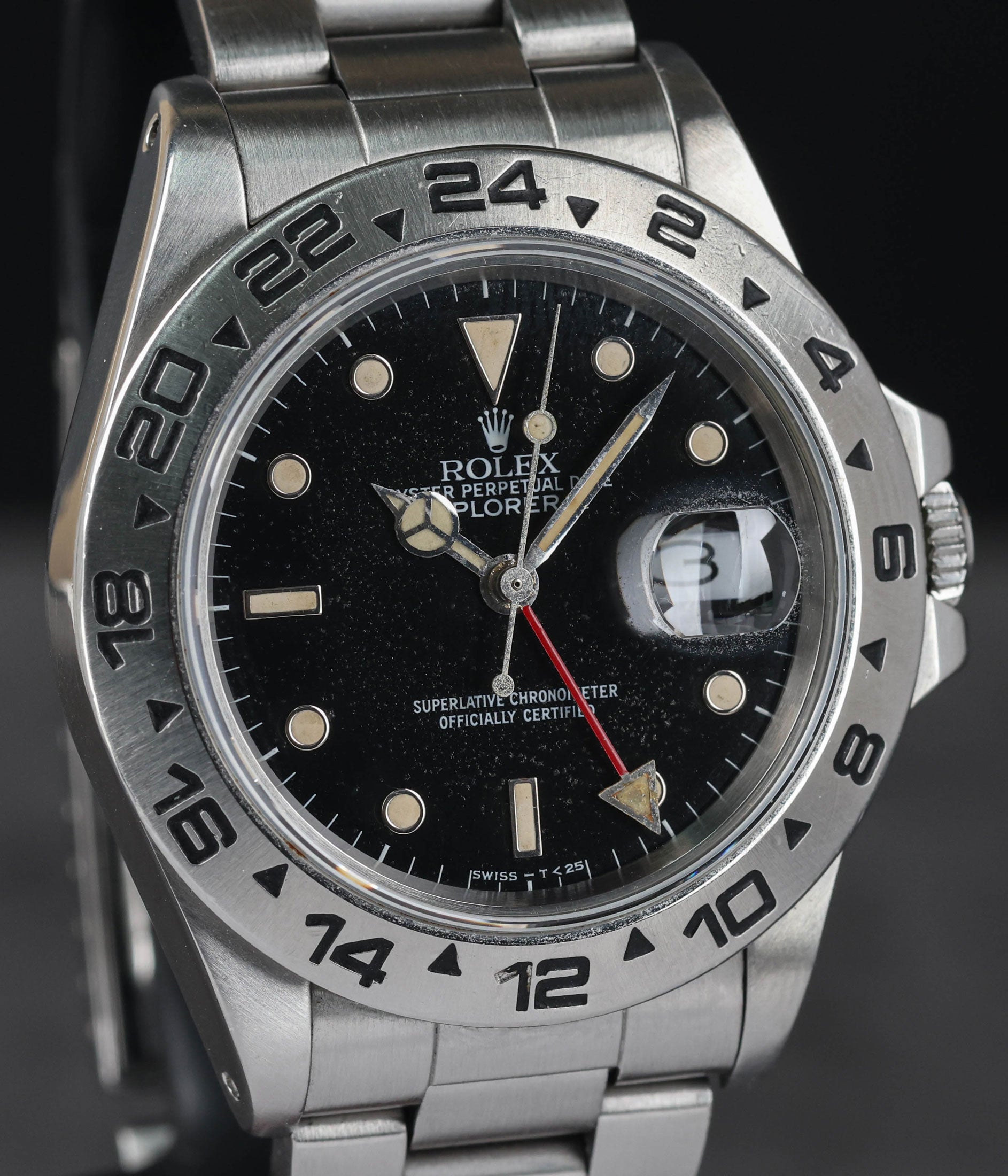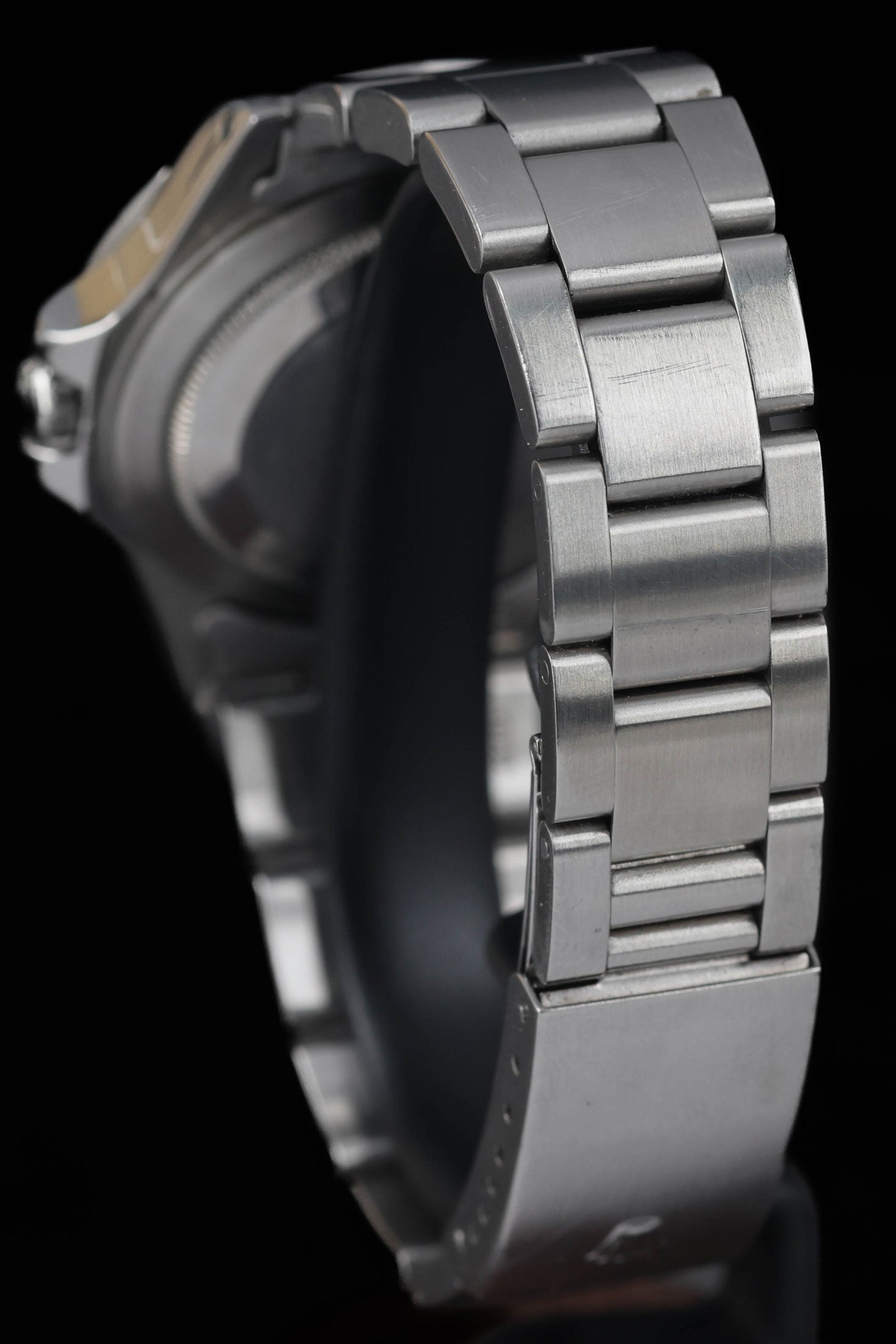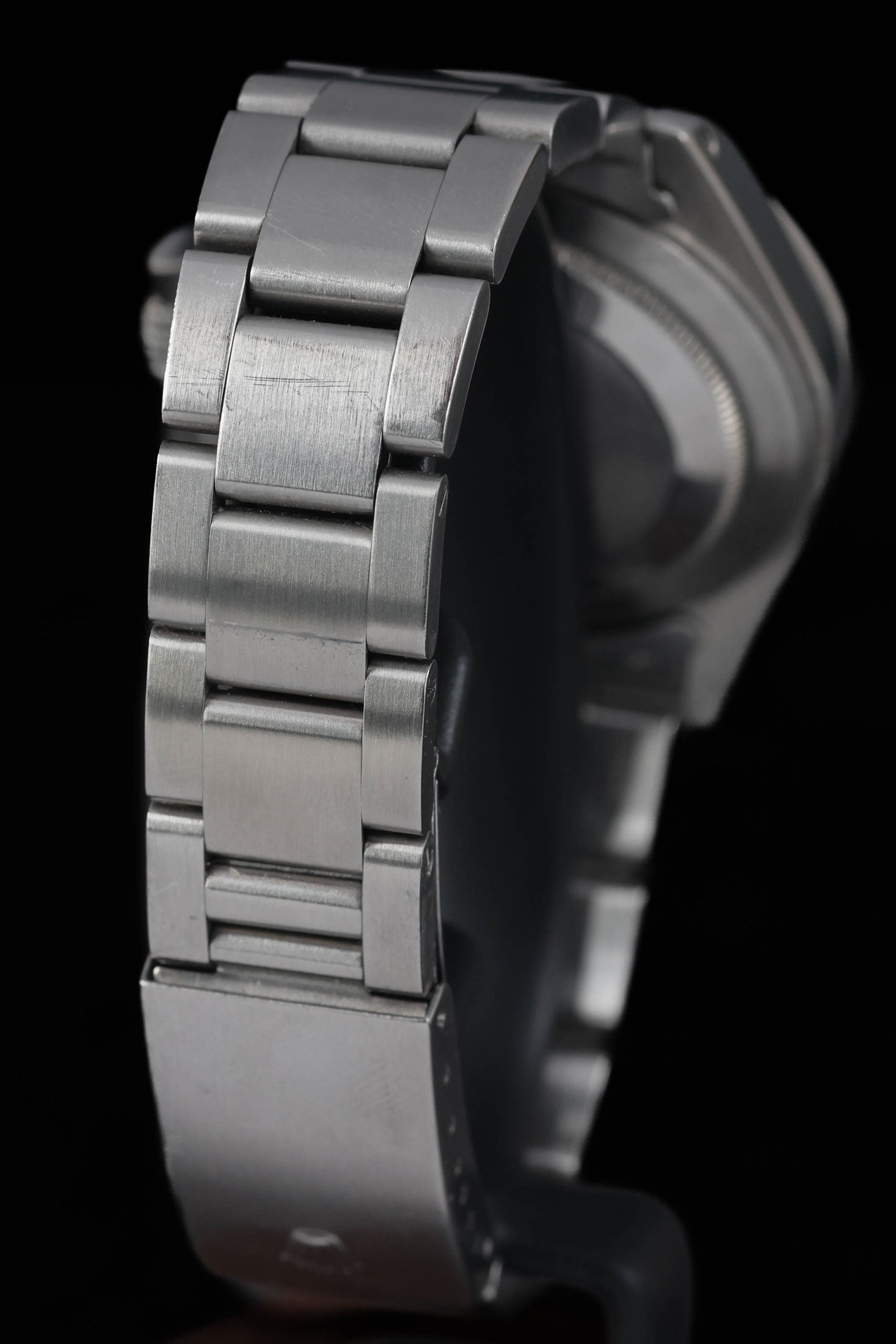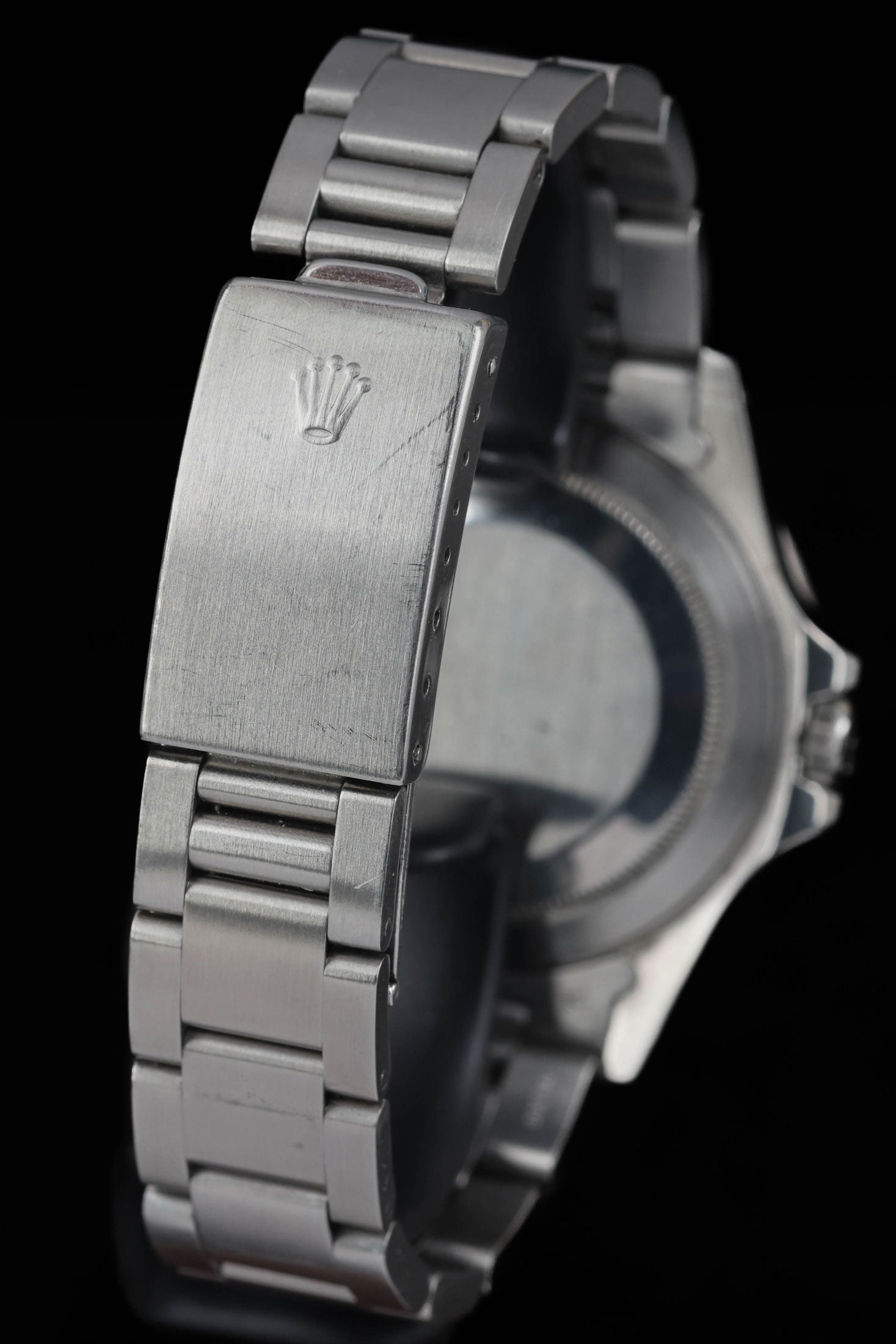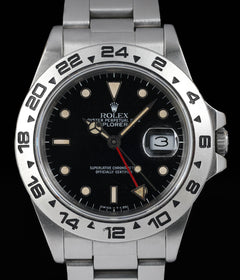Crown Vintage
Rolex Explorer II 16550 'Stardust Dial' 40mm 1988
Rolex Explorer II 16550 'Stardust Dial' 40mm 1988
Couldn't load pickup availability
Experience the allure of a sought-after transitional reference in the Explorer II lineup. Housed in a 40mm stainless steel case, this model retains intact chamfers and displays only light hairline scratches consistent with careful wear. The Oyster bracelet remains in excellent condition, providing both sturdiness and comfort on the wrist.
What truly distinguishes this piece is its black dial with a subtle “stardust” finish—an organic patina that adds depth and individuality. The luminous hour markers and matching hands have developed a pleasing creamy tone, highlighting the watch’s vintage appeal. Beneath the dial, the Calibre 3085 powers an independently adjustable hour hand, ensuring practical day-to-day functionality.
Balancing rugged construction with a unique dial phenomenon, this 16550 offers a remarkable glimpse into Rolex’s evolution during the late 1980s, serving as an eye-catching yet highly wearable addition to any serious watch rotation.
Share
Why we love this watch
Why we love this watch
Rolex Explorer II 16550 “Stardust Dial” (1988): A Transitional Classic
The Rolex Explorer II has undergone several notable evolutions since its introduction in 1971. Initially launched as Reference 1655, this line targeted professionals operating in low-light environments, such as cavers and polar explorers. Over time, Rolex refined the Explorer II’s design and mechanics, leading to transitional references that bridged earlier engineering with emerging technology. One such example is the Rolex Explorer II 16550. Produced from around 1985 to 1989, it ushered in modern features while preserving some of the distinctive character of previous models. Within this short-lived reference, certain dial variations have captured attention, including what is now commonly referred to as the “stardust dial.”
1. The Background: Explorer II’s Evolution
Rolex introduced the Explorer II in 1971 with the Reference 1655. Designed for individuals working in perpetual darkness or where day and night easily blend—like cavers, mine workers, or polar researchers—the watch featured a large 24-hour hand and a fixed 24-hour bezel. The arrangement allowed wearers to differentiate between AM and PM hours when natural light was absent. Although overshadowed at times by other Rolex sports watches, the Explorer II built up its own following thanks to its straightforward functionality, robust Oyster case, and distinctive aesthetic elements like the wide arrow-tipped hand in orange.
By the mid-1980s, Rolex sought to update the Explorer II to align it with modernised movements and changing watch tastes. That transition led to the introduction of Reference 16550, featuring an updated movement (Calibre 3085), higher water resistance, and an independently adjustable hour hand. This independent hour hand gave the watch dual-time functionality, similar to the GMT-Master II of the era. The 16550 also came in two dial variants: black or white. The white dial version in particular garnered attention, partly due to certain manufacturing nuances that caused colour changes or unusual effects over time—elements that now set some examples apart in the vintage watch world.
2. The Emergence of the “Stardust Dial”
Among the hallmarks of some Explorer II 16550 examples is the so-called “stardust dial.” This informal nickname refers to a visual effect that emerged from how the white (or light-coloured) dial paint aged over time. Originally, Rolex used a specific type of paint and lacquer for the white Explorer II 16550 dial that was intended to remain crisp and bright. However, certain specimens experienced unexpected changes in the paint’s texture or colour, leading to a granular or speckled appearance reminiscent of a star-filled sky when viewed in particular lighting.
This phenomenon is not uniform; some dials show only a gentle sparkle or faint spots, while others exhibit a pronounced shimmer across the entire surface. The term “stardust” is not an official Rolex designation but rather a descriptor used by dealers, watch forums, and those who appreciate the peculiarity of these dials. Like other dial anomalies in vintage Rolex models—such as “spider dials” or “tropical dials”—stardust dials attract attention for their unique, almost accidental aesthetics.
3. The Broader Context of Dial Anomalies
Rolex has long taken pride in quality control, but no manufacturing process is immune to unforeseen reactions or long-term material instabilities. Historically, certain dial paints or lacquers have reacted to UV exposure, humidity, or general ageing. The Explorer II 16550 stardust dial represents one of these outcomes. While some owners prefer a watch that remains close to factory-new condition, others find charm in how these anomalies make each piece one of a kind.
Examples of other dial anomalies from Rolex’s archives include:
• Tropical dials: Brown or copper-like patination on black dials.
• Spider dials: Fine cracking that creates a web-like pattern.
• Patinated luminous plots: Tritium lume turning into warm, creamy hues.
Similar to these anomalies, the stardust dial’s formation is an organic process rather than something Rolex ever intended. As a result, not every 16550 white dial exhibits this effect. It’s encountered in certain production batches, adding rarity and interest for people who enjoy unique visual transformations.
4. The Year 1988: Historical Significance
While Reference 16550 was around from roughly 1985 to 1989, 1988 marks a period when Rolex was making incremental refinements across many models. The Submariner, GMT-Master II, and Daytona lines also saw transitions in movement technology and materials. In that broader context, a 1988 Explorer II 16550 stands out because it represents one of the final years the reference was fully active prior to being phased out. Models produced near the end of a reference’s lifespan sometimes include subtle improvements or minor dial variations, which can enhance collectability.
Additionally, the brand’s shift towards modern features in the late 1980s helped shape consumer expectations. Sapphire crystals, better seals, and high-precision movements brought Rolex closer to the twenty-first-century standard. Therefore, a 1988 Explorer II 16550 can illustrate the brand’s pivot from purely mechanical traditions toward a fusion of tradition and modern manufacturing.
5. Collectability and Market Considerations
Reference 16550 is already considered less common than some of Rolex’s more widely produced sports models, as it enjoyed only a brief production run. Within that reference, the stardust dial subset is rarer still. However, there are nuances to market reception of dial anomalies. Some individuals prize the watch specifically for its unusual dial, while others prefer a standard finish.
6. The 16550’s Legacy in the Modern Era
Rolex replaced the 16550 with the 16570 around 1989, introducing slight design tweaks and a Calibre 3185. The 16570 continued to evolve, eventually leading to the current Explorer II line with a 42 mm case. Yet, references like the 16550 remain important in demonstrating Rolex’s method of refining existing models through iterative improvements.
These transitional pieces often receive increasing attention. They highlight how Rolex approached innovation in the 1980s—embracing improvements in water resistance, luminous materials, and movement engineering without losing the essential identity established in the original Explorer II. The stardust dial phenomenon underscores the unpredictability of vintage watch collecting, where unintended dial effects can drastically reshape the watch’s desirability over time.
7. Conclusion
The Rolex Explorer II 16550 “stardust dial” from 1988 symbolises a unique period in Rolex’s development, combining the brand’s inclination for incremental upgrades with a chance dial effect that later became a conversation starter among watch aficionados. As a short-lived transitional reference, the 16550 bridged the gap between the earlier 1655 and the longer-running 16570. Mechanical enhancements—such as the Calibre 3085 movement and the introduction of a sapphire crystal—brought it closer to modern standards, while its fixed 24-hour bezel stayed true to the Explorer II’s original mission.
For those lucky enough to own or seek out a 16550 from the late 1980s, the combination of robust construction, distinctive dial changes, and transitional significance ensures a piece that merges practicality and historical interest. It can be worn daily, provided it’s serviced properly, or reserved for special occasions as a conversation piece that exemplifies Rolex’s layering of tradition and incremental innovation. While collectors continue to focus on the brand’s revered tool watches—like the Submariner or Daytona—references like the Explorer II 16550 are a reminder that gems can be found among the transitional lines. The stardust dial only strengthens that perspective, turning a straightforward tool watch into a charismatic artifact of watchmaking’s past.
Case & Bracelet
Case & Bracelet
Both the case and bracelet remain in excellent shape, revealing only subtle hairline marks from gentle wear.
Dial & Hands
Dial & Hands
The dial and hands present in superb vintage form, with the hour markers and hands displaying a warm, creamy patina. Adding further character, the black dial reveals a subtle “stardust” effect.
Warranty & Condition
Warranty & Condition
Crown Vintage Watches provides a minimum 3-month mechanical warranty on pre-owned watches, from the date of purchase.
The warranty covers mechanical defects only.
The warranty does not cover damages such as scratches, finish, crystals, glass, straps (leather, fabric or rubber damage due to wear and tear), damage resulting from wear under conditions exceeding the watch manufacturer’s water resistance limitations, and damage due to physical and or accidental abuse.
Please note, water resistance is neither tested nor guaranteed.
Shipping and insurance costs for warranty returns to us must be covered by the customer. Returns must be shipped via traceable courier. Return shipment must be pre-paid and fully insured. Collect shipping will be refused. In case of loss or damages, the customer is liable.
Our Pledge
At Crown Vintage Watches, we stand by the authenticity of every product we sell. For added peace of mind, customers are welcome to have items independently authenticated at their own expense.
Condition
Due to the nature of vintage timepieces, all watches are sold as is. We will accurately describe the current condition and working order of all watches we sell to the best of our ability.
Shipping & Refund
Shipping & Refund
